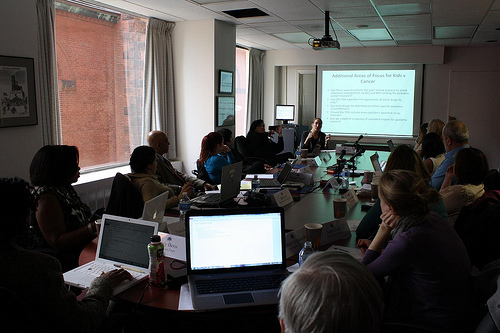
by Yanick Rice Lamb | Aug 16, 2018 | |
Publication No. 11 Creative Work/Article Lamb, Y.R. (March 29, 2018). “50 Years After the Kerner Commission, Little Progress for People of Color in Media.” Women’s Media Center.http://www.womensmediacenter.com/news-features/50-years-after-the-kerner-commission-little-progress-for-people-of-color-in-media Synopsis Fifty years ago, the Kerner Commission blamed media portrayals, or lack thereof, for contributing to nationwide uprisings in the summer of 1967 by African Americans who were sick and tired of being sick and tired, to paraphrase Fannie Lou Hamer. The National Advisory Commission on Civil Disorders, as it was officially called, appointed by President Lyndon Johnson to investigate the underlying causes of the unrest, made some sobering findings, concluding, “Our nation is moving toward two societies, one black, one white — separate and unequal.” It also found that the media presented a fragmented picture to the public that failed to show the everyday lives of black and brown people and that underplayed disparities in areas such as education, housing, employment, income, health, and policing. To mark the 50th anniversary of the report, commemorative conferences, studies, and other research have assessed progress in the last half-century. The picture is decidedly mixed, with African-American unemployment, for example, consistently remaining about double the rate for whites, the Economic Policy Institute found. More people of color work in some segments of media, but nothing near fair representation. Coverage is more diverse, but stereotypes and distortions persist. Impact This article was circulated widely on social media with references to many of the points for the need for more diversity in journalism to reduce stereotypes and misleading coverage. Black journalists’ expertise and sensibilities are essential to providing a fair and balanced view of the world, especially communities of...

by Yanick Rice Lamb | Aug 15, 2018 | |
Table of Contents Please click links or see thumb drive. Also see portfolio at https://yanickricelamb.com/howard-portfolio/ Cover Letter Application (Section I) Curriculum Vitae Letters of Recommendation/External Reviews (4 minimum from peer institutions) References Associated Press letter See APT Committee for the 4 letters/external reviews Relevant and Recent Publications Special Issue of Howard Journal of Communications Refereed Book Chapters Refereed Articles Evidence of participation in creative activities Grant award letters, awards and certificates N/AEvidence of board certification (Clinical Faculty) Evidence of involvement in reviewing manuscripts and grants. Evidence of participation of professional development Evidence of service to the university, school/college, hospital, department, and the community Evidence of participation in professional societies Leadership Activity Teaching Activity Presentations Student Evaluations N/AResident Evaluations (Health Sciences) Honors and Thank You...

by Yanick Rice Lamb | Aug 13, 2018 | |
Publication No. 2 Major Production: In-Depth Special Report Title: “The Toxin Connection: The Impact of Rubber Production on Health in Northeast Ohio” Principal Investigator: Lamb, Yanick Rice Synopsis “The Toxin Connection” is an interactive series examining occupational and environmental health in an industrial community as part of a Social Justice Investigative Journalism Fellowship. The focus is on the generational impact of toxins that have resulted in elevated levels of cancer and auto-immune diseases. Multimedia will include photos, video, data visualization and mapping. I have been conducting in-depth interviews with patients, physicians, researchers, environmentalists and politicians as well as health, public policy, industry and public officials who essentially gave corporations a pass by maintaining low regulatory standards. Impact/Recognition This is an under-reported environmental and medical story. The goal of “The Toxin Connection” is to provide public service journalism by answering questions long on the minds of local residents who have endured decades of silence and indifference like in Flint, Michigan. My investigation would sort through myths and facts; dig into the data and other research to highlight why disease rates are so high; discuss genomics; and delve into allegations of political inaction, and corporate influence or suppression of possible health risks. I would examine health care over the years, environmental monitoring historically, and the status and impact of legislation, including the Toxic Substances Control Act. My project has been accepted for publication in Belt Magazine and the Cleveland Plain Dealer. I was awarded a $8,800 grant from the Schuster Institute for Investigative Journalism at Brandeis University and the Fund for Investigative Journalism, which includes representatives from leading news organizations such as the Chicago...

by Yanick Rice Lamb | Aug 10, 2018 | |
Professional Development Howard University Chair Leadership Academy, 2017-18 National Association of Black Journalists conference in New Orleans, 2017 Academic fellowship for Association of Health Care Journalists in Orlando, Fla., 2017 Selected as a returning John A. Hartford/Commonwealth Foundation Journalism in Aging & Health Fellow to attend and cover the Gerontological Society of America’s Annual Scientific Meeting, New Orleans, 2016 Age Boom Academy: The Future of Work and Retirement at Columbia University Mailman School of Public Health, 2016 Cancer Reporting Fellowship, National Institutes of Health, 2016 NABJ regional conference, Morgan State University, Baltimore, 2016 Association of Health Care Journalists, Cleveland, 2016 Scripps Howard Journalism Entrepreneurship Institute, Arizona State University, Walter Cronkite School of Journalism and Mass Media, Phoenix, January 2016 American Council on Education (ACE), Leadership Academy for Department Chairs, 2015 Provost’s Office monthly workshops and meetings for department chairs, 2015-present “The Role of Nonprofit Media in a Vibrant Civil Society,”co-sponsored by the Council on Foundations at the Newseum, 2015 “Designing Ethics in the Digital Age,” Newseum, 2015 NABJ, Minneapolis, 2015 Cracking the Code, International Women’s Media Foundation Digital News Entrepreneurs Summit, New York, 2015 New U News Entrepreneurs Working Through Unity Boot Camp, AAJA, 2014 TIE X Boot Camp and Accelerator, Opportunity Hub, Atlanta, 2014 Rainbow PUSH Media Telecommunications Symposium, Washington, 2014 Hack the Gender Gap, PBS MediaShift/Google, West Virginia University, 2014 CollabSpace D.C., PBS MediaShift/Reynolds Journalism Institute, Washington Post, 2014 “Introduction to Mobile Journalism,” five-week Massive Open Online Course (MOOC), Knight Center for Journalism, July to August 2014 National Association of Black Journalists conference, including half-day boot camp on Google tools, Boston, August 2014 Refresher on Final Cut Pro, two...

by Yanick Rice Lamb | Aug 10, 2018 | |
Publication No. 8 Pending Research Refereed Journal Article (Under Review) Lamb, Y.R. (Under review). “The Impact of Body Mass Index on Women’s Physical Health Ratings, Fibroids, Anemia and Infertility.” Journal of the National Medical Association (Elsevier). Abstract Obesity is considered a global epidemic that will be the leading cause of death by 2020, according to the World Health Organization (WHO). This research supports the regression-related central organizing hypothesis (COH) that the Body Mass Index is explainable by physical health ratings for women across racial and ethnic groups and their self-reports of diagnosed fibroids, anemia and infertility. Multiple regression and percent distribution were used to address the COH by analyzing data from the Collaborative Psychiatric Epidemiology Surveys (CPES) as part of the National Survey of American Life (NSAL), 2001-2003. Based on the differential effects theory, this research helps to fill a void in the literature on reproductive health through the lens of obesity as it relates to race, ethnicity and gender. It may also have clinical and public health implications, such as enhancing awareness and wellness outcomes among black women who suffer disproportionately from obesity, infertility, fibroids and anemia, which is a risk factor for pregnancy complications and low birthweight. Impact The intersection of reproductive health and obesity are rarely discussed as they relate to black women, who are already disproportionately affected by health disparities. African-American women are at the center of the global obesity epidemic that WHO predicts will be the leading cause of death by 2020. About four out of five African-American women are overweight or obese — the highest rate of any group in the United States (Office...







Recent Comments